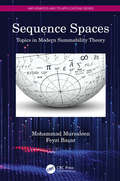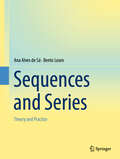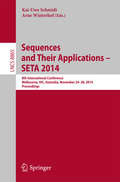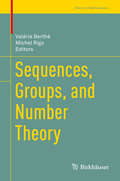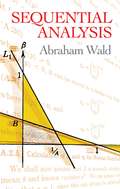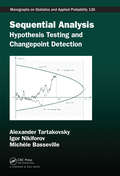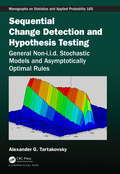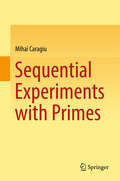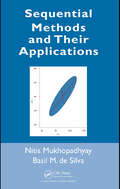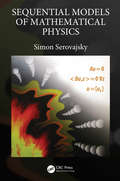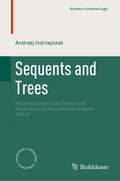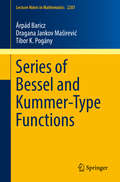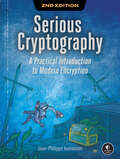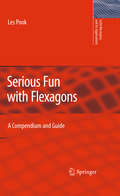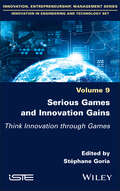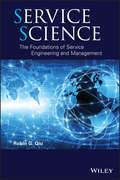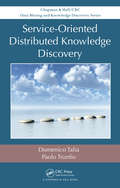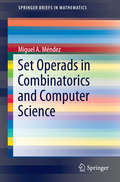- Table View
- List View
Sequence Spaces: Topics in Modern Summability Theory (Mathematics and its Applications)
by Mohammad Mursaleen Feyzi BaşarThis book is aimed at both experts and non-experts with an interest in getting acquainted with sequence spaces, matrix transformations and their applications. It consists of several new results which are part of the recent research on these topics. It provides different points of view in one volume, e.g. their topological properties, geometry and summability, fuzzy valued study and more. This book presents the important role sequences and series play in everyday life, it covers geometry of Banach Sequence Spaces, it discusses the importance of generalized limit, it offers spectrum and fine spectrum of several linear operators and includes fuzzy valued sequences which exhibits the study of sequence spaces in fuzzy settings. This book is the main attraction for those who work in Sequence Spaces, Summability Theory and would also serve as a good source of reference for those involved with any topic of Real or Functional Analysis.
Sequences and Series: Theory and Practice
by Ana Alves de Sá Bento LouroThis book investigates sequences and series with a clear and focused approach, presenting key theoretical concepts alongside a diverse range of examples and proposed problems, complete with solutions. It is designed to be largely self-contained, offering formal proofs when they enhance understanding. Solutions are provided separately, encouraging students to develop their problem-solving skills. Chapters 1 and 2 focus on sequences and numerical series, drawing primarily on knowledge acquired in high school. Calculus concepts become important from the end of Chapter 2, extending into Chapter 3, which is entirely dedicated to function series. This includes in-depth discussions of Taylor, Maclaurin, and Fourier series. Many of the exercises have been rigorously tested in actual classes and exams. The book is enriched by historical facts about mathematicians who have contributed to the subject, fostering students' motivation. It is valuable reading for undergraduates in mathematics, engineering, and other STEM-related fields, as well as for any student with a specific interest in the matter.
Sequences and Their Applications - SETA 2014
by Arne Winterhof Kai-Uwe SchmidtThis book constitutes the refereed proceedings of the 8th International Conference on Sequences and Their Applications, SETA 2014, held in Melbourne, VIC, Australia, in November 2014. The 24 full papers presented together with 2 invited papers were carefully reviewed and selected from 36 submissions. The papers have been organized in topical sections on Boolean functions, perfect sequences, correlation of arrays, relative difference sets, aperiodic correlation, pseudorandom sequences and stream ciphers, crosscorrelation of sequences, prime numbers in sequences, OFDM and CDMA, and frequency-hopping sequences.
Sequences, Groups, and Number Theory
by Valérie Berthé Michel RigoThis collaborative book presents recent trends on the study of sequences, including combinatorics on words and symbolic dynamics, and new interdisciplinary links to group theory and number theory. Other chapters branch out from those areas into subfields of theoretical computer science, such as complexity theory and theory of automata. The book is built around four general themes: number theory and sequences, word combinatorics, normal numbers, and group theory. Those topics are rounded out by investigations into automatic and regular sequences, tilings and theory of computation, discrete dynamical systems, ergodic theory, numeration systems, automaton semigroups, and amenable groups. This volume is intended for use by graduate students or research mathematicians, as well as computer scientists who are working in automata theory and formal language theory. With its organization around unified themes, it would also be appropriate as a supplemental text for graduate level courses.
Sequential Analysis (Phoenix Edition Ser.)
by Abraham WaldThe first to solve the general problem of sequential tests of statistical hypotheses, the author of this text explains his revolutionary theory of the sequential probability ratio test and its applications. 1947 edition.
Sequential Analysis and Observational Methods for the Behavioral Sciences
by Vicenç Quera Roger BakemanBehavioral scientists - including those in psychology, infant and child development, education, animal behavior, marketing and usability studies - use many methods to measure behavior. Systematic observation is used to study relatively natural, spontaneous behavior as it unfolds sequentially in time. This book emphasizes digital means to record and code such behavior; while observational methods do not require them, they work better with them. Key topics include devising coding schemes, training observers and assessing reliability, as well as recording, representing and analyzing observational data. In clear and straightforward language, this book provides a thorough grounding in observational methods along with considerable practical advice. It describes standard conventions for sequential data and details how to perform sequential analysis with a computer program developed by the authors. The book is rich with examples of coding schemes and different approaches to sequential analysis, including both statistical and graphical means.
Sequential Analysis: Hypothesis Testing and Changepoint Detection (Chapman & Hall/CRC Monographs on Statistics and Applied Probability)
by Alexander Tartakovsky Igor Nikiforov Michele BassevilleSequential Analysis: Hypothesis Testing and Changepoint Detection systematically develops the theory of sequential hypothesis testing and quickest changepoint detection. It also describes important applications in which theoretical results can be used efficiently. The book reviews recent accomplishments in hypothesis testing and changepoint detecti
Sequential Change Detection and Hypothesis Testing: General Non-i.i.d. Stochastic Models and Asymptotically Optimal Rules
by Alexander TartakovskyStatistical methods for sequential hypothesis testing and changepoint detection have applications across many fields, including quality control, biomedical engineering, communication networks, econometrics, image processing, security, etc. This book presents an overview of methodology in these related areas, providing a synthesis of research from the last few decades. The methods are illustrated through real data examples, and software is referenced where possible. The emphasis is on providing all the theoretical details in a unified framework, with pointers to new research directions.
Sequential Experimentation in Clinical Trials
by Mei-Chiung Shih Tze Leung Lai Jay BartroffSequential Experimentation in Clinical Trials: Design and Analysis is developed from decades of work in research groups, statistical pedagogy, and workshop participation. Different parts of the book can be used for short courses on clinical trials, translational medical research, and sequential experimentation. The authors have successfully used the book to teach innovative clinical trial designs and statistical methods for Statistics Ph.D. students at Stanford University. There are additional online supplements for the book that include chapter-specific exercises and information. Sequential Experimentation in Clinical Trials: Design and Analysis covers the much broader subject of sequential experimentation that includes group sequential and adaptive designs of Phase II and III clinical trials, which have attracted much attention in the past three decades. In particular, the broad scope of design and analysis problems in sequential experimentation clearly requires a wide range of statistical methods and models from nonlinear regression analysis, experimental design, dynamic programming, survival analysis, resampling, and likelihood and Bayesian inference. The background material in these building blocks is summarized in Chapter 2 and Chapter 3 and certain sections in Chapter 6 and Chapter 7. Besides group sequential tests and adaptive designs, the book also introduces sequential change-point detection methods in Chapter 5 in connection with pharmacovigilance and public health surveillance. Together with dynamic programming and approximate dynamic programming in Chapter 3, the book therefore covers all basic topics for a graduate course in sequential analysis designs.
Sequential Experiments with Primes
by Mihai CaragiuWith a specific focus on the mathematical life in small undergraduate colleges, this book presents a variety of elementary number theory insights involving sequences largely built from prime numbers and contingent number-theoretic functions. Chapters include new mathematical ideas and open problems, some of which are proved in the text. Vector valued MGPF sequences, extensions of Conway's Subprime Fibonacci sequences, and linear complexity of bit streams derived from GPF sequences are among the topics covered in this book. This book is perfect for the pure-mathematics-minded educator in a small undergraduate college as well as graduate students and advanced undergraduate students looking for a significant high-impact learning experience in mathematics.
Sequential Learning and Decision-Making in Wireless Resource Management
by Rong Zheng Cunqing HuaThis book lays out the theoretical foundation of the so-called multi-armed bandit (MAB) problems and puts it in the context of resource management in wireless networks. Part I of the book presents the formulations, algorithms and performance of three forms of MAB problems, namely, stochastic, Markov and adversarial. Covering all three forms of MAB problems makes this book unique in the field. Part II of the book provides detailed discussions of representative applications of the sequential learning framework in cognitive radio networks, wireless LANs and wireless mesh networks. Both individuals in industry and those in the wireless research community will benefit from this comprehensive and timely treatment of these topics. Advanced-level students studying communications engineering and networks will also find the content valuable and accessible.
Sequential Methods and Their Applications
by Nitis Mukhopadhyay Basil M. de SilvaInteractively Run Simulations and Experiment with Real or Simulated Data to Make Sequential Analysis Come AliveTaking an accessible, nonmathematical approach to this field, Sequential Methods and Their Applications illustrates the efficiency of sequential methodologies when dealing with contemporary statistical challenges in many areas.The book fir
Sequential Models of Mathematical Physics
by Simon SerovajskyThe equations of mathematical physics are the mathematical models of the large class of phenomenon of physics, chemistry, biology, economics, etc. In Sequential Models of Mathematical Physics, the author considers the justification of the process of constructing mathematical models. The book seeks to determine the classic, generalized and sequential solutions, the relationship between these solutions, its direct physical sense, the methods of its practical finding, and its existence. Features Describes a sequential method based on the construction of space completion, as well as its applications in number theory, the theory of distributions, the theory of extremum, and mathematical physics Presentation of the material is carried out on the simplest example of a one-dimensional stationary heat transfer process; all necessary concepts and constructions are introduced and illustrated with elementary examples, which makes the material accessible to a wide area of readers The solution of a specific mathematical problem is obtained as a result of the joint application of methods and concepts from completely different mathematical directions
Sequents and Trees: An Introduction to the Theory and Applications of Propositional Sequent Calculi (Studies in Universal Logic)
by Andrzej IndrzejczakThis textbook offers a detailed introduction to the methodology and applications of sequent calculi in propositional logic. Unlike other texts concerned with proof theory, emphasis is placed on illustrating how to use sequent calculi to prove a wide range of metatheoretical results. The presentation is elementary and self-contained, with all technical details both formally stated and also informally explained. Numerous proofs are worked through to demonstrate methods of proving important results, such as the cut-elimination theorem, completeness, decidability, and interpolation. Other proofs are presented with portions left as exercises for readers, allowing them to practice techniques of sequent calculus.After a brief introduction to classical propositional logic, the text explores three variants of sequent calculus and their features and applications. The remaining chapters then show how sequent calculi can be extended, modified, and applied to non-classical logics, including modal, intuitionistic, substructural, and many-valued logics.Sequents and Trees is suitable for graduate and advanced undergraduate students in logic taking courses on proof theory and its application to non-classical logics. It will also be of interest to researchers in computer science and philosophers.
Series of Bessel and Kummer-Type Functions (Lecture Notes in Mathematics #2207)
by Árpád Baricz Dragana Jankov Maširević Tibor K. PogányThis book is devoted to the study of certain integral representations for Neumann, Kapteyn, Schlömilch, Dini and Fourier series of Bessel and other special functions, such as Struve and von Lommel functions. The aim is also to find the coefficients of the Neumann and Kapteyn series, as well as closed-form expressions and summation formulas for the series of Bessel functions considered. Some integral representations are deduced using techniques from the theory of differential equations. The text is aimed at a mathematical audience, including graduate students and those in the scientific community who are interested in a new perspective on Fourier–Bessel series, and their manifold and polyvalent applications, mainly in general classical analysis, applied mathematics and mathematical physics.
Serious Cryptography, 2nd Edition: A Practical Introduction to Modern Encryption
by Jean-Philippe AumassonCrypto can be cryptic. Serious Cryptography, 2nd Edition arms you with the tools you need to pave the way to understanding modern crypto.This thoroughly revised and updated edition of the bestselling introduction to modern cryptography breaks down fundamental mathematical concepts without shying away from meaty discussions of how they work. In this practical guide, you&’ll gain immeasurable insight into topics like authenticated encryption, secure randomness, hash functions, block ciphers, and public-key techniques such as RSA and elliptic curve cryptography.You&’ll find coverage of topics like:The basics of computational security, attacker models, and forward secrecyThe strengths and limitations of the TLS protocol behind HTTPS secure websitesQuantum computation and post-quantum cryptographyHow algorithms like AES, ECDSA, Ed25519, Salsa20, and SHA-3 workAdvanced techniques like multisignatures, threshold signing, and zero-knowledge proofsEach chapter includes a discussion of common implementation mistakes using real-world examples and details what could go wrong and how to avoid these pitfalls. And, true to form, you&’ll get just enough math to show you how the algorithms work so that you can understand what makes a particular solution effective—and how they break. NEW TO THIS EDITION: This second edition has been thoroughly updated to reflect the latest developments in cryptography. You&’ll also find a completely new chapter covering the cryptographic protocols in cryptocurrency and blockchain systems.Whether you&’re a seasoned practitioner or a beginner looking to dive into the field, Serious Cryptography will demystify this often intimidating topic. You&’ll grow to understand modern encryption and its applications so that you can make better decisions about what to implement, when, and how.
Serious Fun with Flexagons
by L. P. PookA flexagon is a motion structure that has the appearance of a ring of hinged polygons. It can be flexed to display different pairs of faces, usually in cyclic order. Flexagons can be appreciated as toys or puzzles, as a recreational mathematics topic, and as the subject of serious mathematical study. Workable paper models of flexagons are easy to make and entertaining to manipulate. The mathematics of flexagons is complex, and how a flexagon works is not immediately obvious on examination of a paper model. Recent geometric analysis, included in the book, has improved theoretical understanding of flexagons, especially relationships between different types. This profusely illustrated book is arranged in a logical order appropriate for a textbook on the geometry of flexagons. It is written so that it can be enjoyed at both the recreational mathematics level, and at the serious mathematics level. The only prerequisite is some knowledge of elementary geometry, including properties of polygons. A feature of the book is a compendium of over 100 nets for making paper models of some of the more interesting flexagons, chosen to complement the text. These are accurately drawn and reproduced at half full size. Many of the nets have not previously been published. Instructions for assembling and manipulating the flexagons are included.
Serious Games and Innovation Gains: Think Innovation through Games (ISTE Invoiced)
by St Phane GoriaOver the past thirty years or so, serious games, gaming and playful activities have come to occupy an important place in organizations. While this phenomenon is an ancient one, the use of games for serious purposes has become widespread over the last two centuries, and their development has been exponential, stimulated by that of information technologies. As a result, it has become necessary to understand the specificities of these games and play activities in order to innovate and create value within organizations. For this reason, this book aims to enlighten the reader on their variety, their specific features and what they can bring to an organization. Serious Games and Innovation Gains first uncovers the history of these kinds of games and play, their main characteristics and what they can bring in terms of a vision of the future. Above all, this book explores how these games and forms of play can be implemented, especially in areas such as progressive development, education, agility support, academic research, as well as military thinking, cyber defense or knowledge base building contexts.
Serious Games for Enhancing Law Enforcement Agencies: From Virtual Reality to Augmented Reality (Security Informatics and Law Enforcement)
by Babak AkhgarThis book provides a comprehensive and practically minded introduction into serious games for law enforcement agencies. Serious games offer wide ranging benefits for law enforcement with applications from professional trainings to command-level decision making to the preparation for crises events. This book explains the conceptual foundations of virtual and augmented reality, gamification and simulation. It further offers practical guidance on the process of serious games development from user requirements elicitation to evaluation. The chapters are intended to provide principles, as well as hands-on knowledge to plan, design, test and apply serious games successfully in a law enforcement environment. A diverse set of case studies showcases the enormous variety that is possible in serious game designs and application areas and offers insights into concrete design decisions, design processes, benefits and challenges. The book is meant for law enforcement professionals interested in commissioning their own serious games as well as game designers interested in collaborative pedagogy and serious games for the law enforcement and security sector.
Service Network Design of Bike Sharing Systems
by Patrick VogelThis monograph presents a tactical planning approach for service network design in metropolitan areas. Designing the service network requires the suitable aggregation of demand data as well as the anticipation of operational relocation decisions. To this end, an integrated approach of data analysis and mathematical optimization is introduced. The book also includes a case study based on real-world data to demonstrate the benefit of the proposed service network design approach. The target audience comprises primarily research experts in the field of traffic engineering, but the book may also be beneficial for graduate students.
Service Science: The Foundations of Service Engineering and Management
by Robin G. Qiul natures Computational thinking and system modeling such as abstraction, digitalization, holistic perspectives, and analytics Plentiful examples of service organizations such as automobile after-sale services, global project management networks, and express delivery services An interdisciplinary emphasis that includes integrated approaches from the fields of mathematics, engineering, industrial engineering, business, operations research, and management science A detailed analysis of the key concepts and body of knowledge for readers to master the foundations of service management Service Science: The Foundations of Service Engineering and Management is an ideal reference for practitioners in the contemporary service engineering and management field as well as researchers in applied mathematics, statistics, business/management science, operations research, industrial engineering, and economics. The book is also appropriate as a text for upper-undergraduate and graduate-level courses in industrial engineering, operations research, and management science as well as MBA students studying service management.
Service-Oriented Distributed Knowledge Discovery
by Paolo Trunfio Domenico TaliaA new approach to distributed large-scale data mining, service-oriented knowledge discovery extracts useful knowledge from today's often unmanageable volumes of data by exploiting data mining and machine learning distributed models and techniques in service-oriented infrastructures. Service-Oriented Distributed Knowledge Discovery presents techniqu
Services for Aging Persons in China: Spatial Variations in Supply and Demand (Global Perspectives on Health Geography)
by Xiaoping Shen Shangyi Zhou Xiulan ZhangThis volume draws upon one of the first comprehensive studies on the regional variations of services for aging persons in China to provide an empirical and theoretical understanding of the impact of China's rapidly growing aging population on the country's socioeconomic, cultural, and political systems. In three parts, the manuscript combines case-oriented comparative methods with variable-oriented statistical and GIS analyses to examine the spatial patterns and relationships between supply and demand of affordable and accessible services for aging persons in China. Part one gives a historical review of population aging in China, including the development of services for aging persons and government policies and programs geared towards elders. Part two provides an analysis of spatial variations of supply and demand for services including food, housing, health, and community services for aging persons. Part three uses case studies to analyse the regional and local dimensions of elderly services. Suggestions are made for future planning, development, and policies. This book will appeal to policy makers, city planners, service providing businesses, and advanced undergraduate and graduate students studying economic geography, planning, and regional development.
Set Function T: An Account on F. B. Jones' Contributions to Topology (Developments in Mathematics #67)
by Sergio MacíasThis book presents, in a clear and structured way, the set function \mathcal{T} and how it evolved since its inception by Professor F. Burton Jones in the 1940s. It starts with a very solid introductory chapter, with all the prerequisite material for navigating through the rest of the book. It then gradually advances towards the main properties, Decomposition theorems, \mathcal{T}-closed sets, continuity and images, to modern applications.The set function \mathcal{T} has been used by many mathematicians as a tool to prove results about the semigroup structure of the continua, and about the existence of a metric continuum that cannot be mapped onto its cone or to characterize spheres. Nowadays, it has been used by topologists worldwide to investigate open problems in continuum theory.This book can be of interest to both advanced undergraduate and graduate students, and to experienced researchers as well. Its well-defined structure make this book suitable not only for self-study but also as support material to seminars on the subject. Its many open problems can potentially encourage mathematicians to contribute with further advancements in the field.
Set Operads in Combinatorics and Computer Science
by Miguel A. MéndezThis monograph has two main objectives. The first one is to give a self-contained exposition of the relevant facts about set operads, in the context of combinatorial species and its operations. This approach has various advantages: one of them is that the definition of combinatorial operations on species, product, sum, substitution and derivative, are simple and natural. They were designed as the set theoretical counterparts of the homonym operations on exponential generating functions, giving an immediate insight on the combinatorial meaning of them. The second objective is more ambitious. Before formulating it, authors present a brief historic account on the sources of decomposition theory. For more than forty years decompositions of discrete structures have been studied in different branches of discrete mathematics: combinatorial optimization, network and graph theory, switching design or boolean functions, simple multi-person games and clutters, etc.
